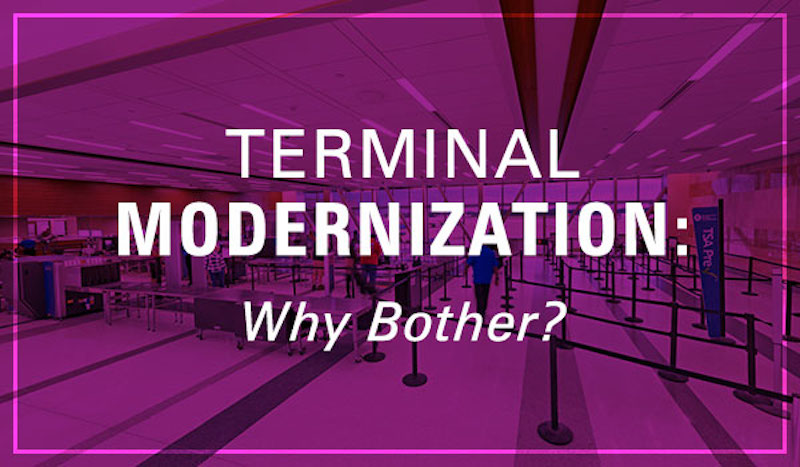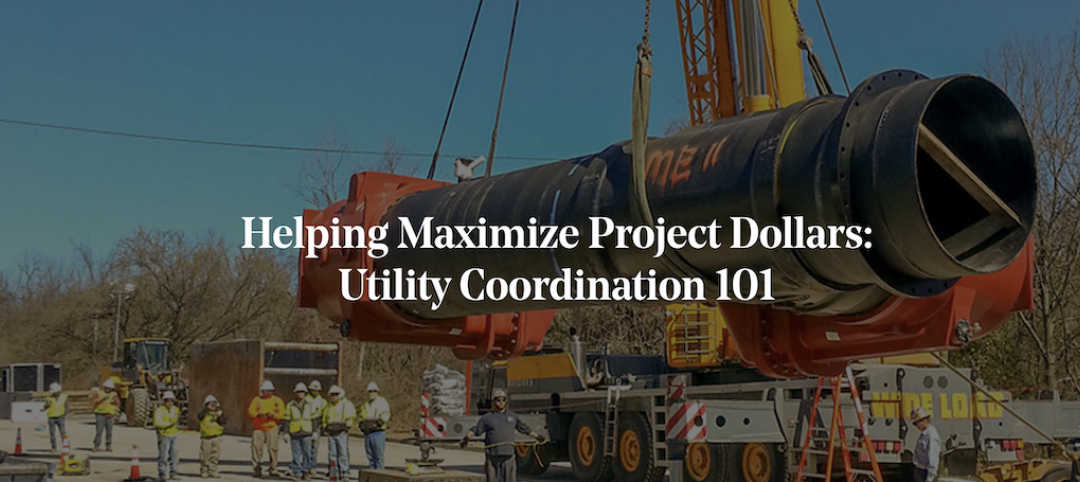Every business evaluates potential projects based on costs and potential return on investment. While terminal modernization projects can be complex and upfront costs are often significant, the cost of upgrades can be outweighed by long-term gains. Upgrades can improve the triple bottom line through operational efficiencies, reduced costs, decreased waste and increased revenues as well as improve the passenger experience. In this post, I share highlights from a discussion with Sean Bogart and Altan Cekin about terminal upgrades from the financial and operational perspective.
Wilson Rayfield (WR): What are some of the operational efficiencies that terminal improvements can drive?
Altan Cekin (AC): Improvements to terminals can simplify passenger circulation and increase throughput at and security checkpoints. Reducing walking distances, improving wayfinding and creating more intuitive circulation paths reduce congestion resulting in fewer passenger inquiries and maximized space for concessions.
Sean Bogart (SB): We can only achieve optimal processing time and reduce wait times through an optimal layout for security checkpoints. This includes the queue, which is the best location to educate passengers on proper divest procedures which can have a considerable impact on screening time. TSA’s protocols are frequently changing, and improvements such as automated screening lanes can take up significantly more space than the optimal layout of just 2 years ago, designing with maximum flexibility and adjacent soft space allows an airport to better adopt new technologies that can both enhance and speed up the screening process for passengers.
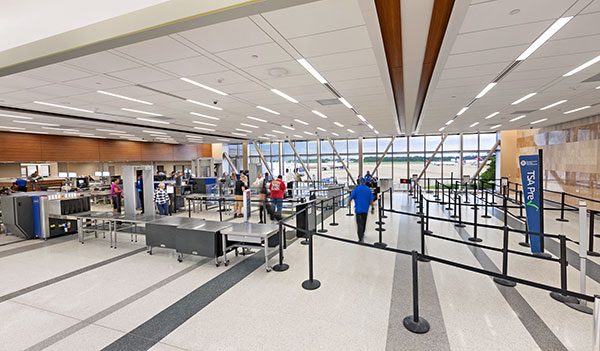 Norfolk International Airport’s updated screening and security checkpoint in Concourse B optimizes space and flow.
Norfolk International Airport’s updated screening and security checkpoint in Concourse B optimizes space and flow.
AC: Beyond circulation though, I believe the greatest benefits of terminal upgrades are the building system efficiencies and the cost savings modernizing equipment can drive.
WR: Upgrading systems and equipment improves comfort for passengers and saves cost. What are some of the more specific benefits of these types of improvements?
SB: Mechanical system upgrades can drive significant efficiencies; there can be substantial savings in maintenance and upkeep. We’ve seen instances where airports are maintaining outdated mechanical systems with equipment that is “band-aided” together where parts that are no longer available must be either custom fabricated or scavenged from one unit to another. So instead of constant repair work, airport staff can focus on preventative maintenance or enhancing the experience
AC: Upgrades also provide the opportunity to take advantage of advanced technology; building systems are becoming smarter and create opportunities for considerable energy savings through increased control. For instance, at Tampa International Airport we installed escalators with sensors that reduce the operational speed when not in use until someone approaches. Another example is lighting. Not only can you increase daylight during upgrades, it provides the opportunity to install motion and daylight sensor controls. At Norfolk International Airport we installed a large skylight that floods the space with natural light so the airport is less dependent on artificial light, which had the added benefit of making the space more pleasant. We also installed lighting at the checkpoint that lowers after the checkpoint closes, but the rest of the airport remains open. Energy is a huge expense for airports and improving systems and embracing technology plays an important role in energy savings.
SB: When we did the modernization at Reno-Tahoe International Airport, the maintenance director said the installation of LED lighting significantly reduced his landfill budget. He no longer needed to dispose of lightbulbs and ballasts as hazardous waste. It dropped this line item on his budget significantly resulting in both an economic and an environmental benefit. So while we often think about energy savings from the perspective of the cost to replace lightbulbs and a reduction in energy consumption, you can also see significant savings through the reduction of waste disposal.
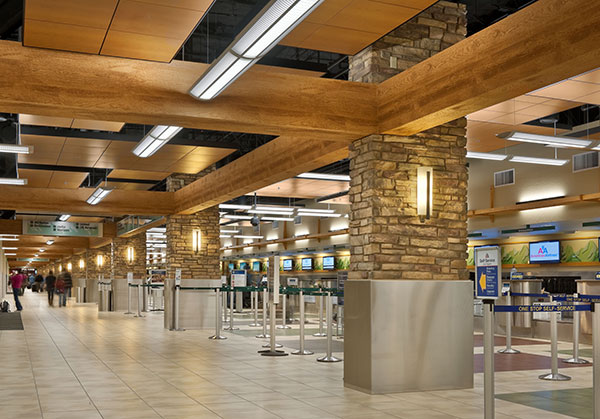 Upgrading lighting at Reno-Tahoe International Airport improves aesthetics as well as provides environmental and financial benefits.
Upgrading lighting at Reno-Tahoe International Airport improves aesthetics as well as provides environmental and financial benefits.
WR: What other maintenance costs can modernization efforts help reduce?
AC: Cleaning and maintaining finishes. Finishes being used now are more durable and therefore help drive operational efficiencies. Staff can keep up with maintenance more easily by using more durable materials like terrazzo for high traffic zones, which lasts over 50 years vs. carpet which ends up in the landfill about every seven years. Airports will spend less time maintaining finishes—that will look dingy no matter how clean it might be.
WR: Are there any other ways in which improvements to building systems impact a facility?
SB: Beyond the heating and cooling energy load, the impact from UV light can bleach out finishes. We are modernizing Fort Lauderdale-Hollywood International Airport, which has older single pane glazing, which does little to reduce both UV light and also solar heat gain.
WR: That’s a great point, Sean. We often talk about the thermal properties of the building envelope, but the light infiltration will degrade interior finishes in addition to providing heat gain. Clearly, there are significant opportunities for cost-savings, but improvements also have an environmental impact, as you mentioned at Reno-Tahoe International Airport and benefit passengers. Upgrading the building envelope can make the environment more pleasant with natural and modern lighting and higher quality finishes that don’t appear completely faded combined with modern efficient systems contribute to a more comfortable facility.
WR: Shifting from cost reduction and efficiencies to revenue, in what ways can terminal modernization increase non-aeronautical revenue?
AC: Our work at Charlotte-Douglas International Airport is a good example where a proposed centralized exit for arriving passengers to baggage claim will also consolidate landside concessions. The exit leads passengers through concessions to a “meet me” point for meeters and greeters – featuring, in addition to concessions, an information desk, public art and a variety of seating options. So, by consolidating these elements we maximize exposure to concessions and get more usable area in an environment with more to offer customers. We know that more content passengers are more likely to spend money, so we’ve really increased the potential value of space in several ways.
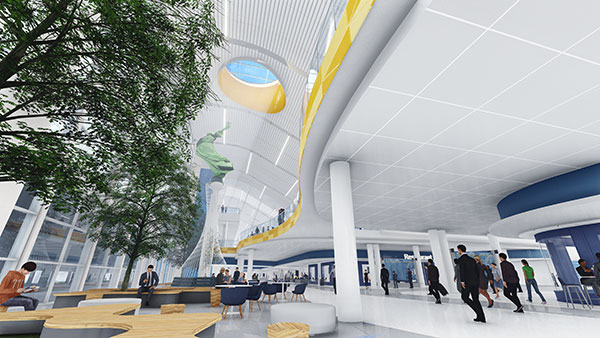 Charlotte Douglas International Airport will feature a new Arrivals hub, where travelers can meet family and friends. The space features ample seating and concessions.
Charlotte Douglas International Airport will feature a new Arrivals hub, where travelers can meet family and friends. The space features ample seating and concessions.
AC: Reorganizing terminal space also impacts advertising revenue, by maximizing exposure and by targeting ads to specific functional areas. Ads about the city are more suited to arriving passengers in baggage claim while airline and airport offerings make more sense along a passenger’s departing route.Through the thoughtful design of an integrated solution, we can designate space for advertising without the adverse effect of visual clutter, even creating new opportunities that become viable to generate revenue.
From lighting to building systems, terminal improvements impact the functional, operational, thermal and aesthetic characteristics of an airport environment. Terminal modernization provides significant triple bottom line benefits: economic, environmental and social. Economic benefits are derived from functional, operational and thermal improvements that reduce costs and increase non-aeronautical revenue. These also drive environmental impacts such as lowering energy use and reducing waste by using durable materials that have a longer life. In terms of social benefits, a more functional, comfortable and aesthetically pleasing space improves the working environment for airport employees and enhances the passenger experience. In the next post, we’ll explore more about how modernization impacts the passenger experience.
More from Author
Gresham Smith | Oct 16, 2024
How AI can augment the design visualization process
Blog author Tim Beecken, AIA, uses the design of an airport as a case-study for AI’s potential in design visualizations.
Gresham Smith | Aug 17, 2023
How to design for adaptive reuse: Don’t reinvent the wheel
Gresham Smith demonstrates the opportunities of adaptive reuse, specifically reusing empty big-box retail and malls, many of which sit unused or underutilized across the country.
Gresham Smith | May 24, 2023
Designing spaces that promote enrollment
Alyson Mandeville, Higher Education Practice Leader, argues that colleges and universities need to shift their business model—with the help of designers.
Gresham Smith | Apr 24, 2023
Smart savings: Commissioning for the hybrid workplace
Joe Crowe, Senior Mechanical Engineer, Gresham Smith, shares smart savings tips for facility managers and building owners of hybrid workplaces.
Gresham Smith | Mar 20, 2023
3 ways prefabrication doubles as a sustainability strategy
Corie Baker, AIA, shares three modular Gresham Smith projects that found sustainability benefits from the use of prefabrication.
Gresham Smith | Jan 19, 2023
Maximizing access for everyone: A closer look at universal design in healthcare facilities
Maria Sanchez, Interior Designer at Gresham Smith, shares how universal design bolsters empathy and equity in healthcare facilities.
Gresham Smith | Dec 20, 2022
Designing for a first-in-the-world proton therapy cancer treatment system
Gresham Smith begins designing four proton therapy vaults for a Flint, Mich., medical center.
Gresham Smith | Nov 21, 2022
An inside look at the airport industry's plan to develop a digital twin guidebook
Zoë Fisher, AIA explores how design strategies are changing the way we deliver and design projects in the post-pandemic world.
Gresham Smith | Feb 13, 2022
Helping maximize project dollars: Utility coordination 101
In this post, I take a look at the utility coordination services our Transportation group offers to our clients in an attempt to minimize delays and avoid unforeseen costs.
Gresham Smith | May 7, 2021
Private practice: Designing healthcare spaces that promote patient privacy
If a facility violates HIPAA rules, the penalty can be costly to both their reputation and wallet, with fines up to $250,000 depending on the severity.

